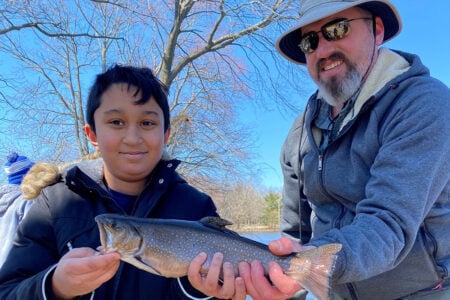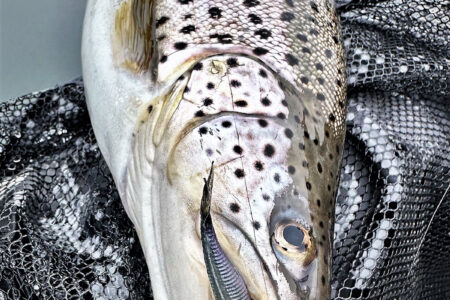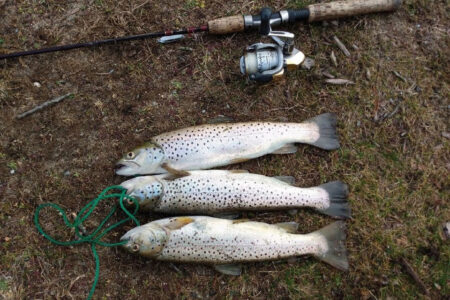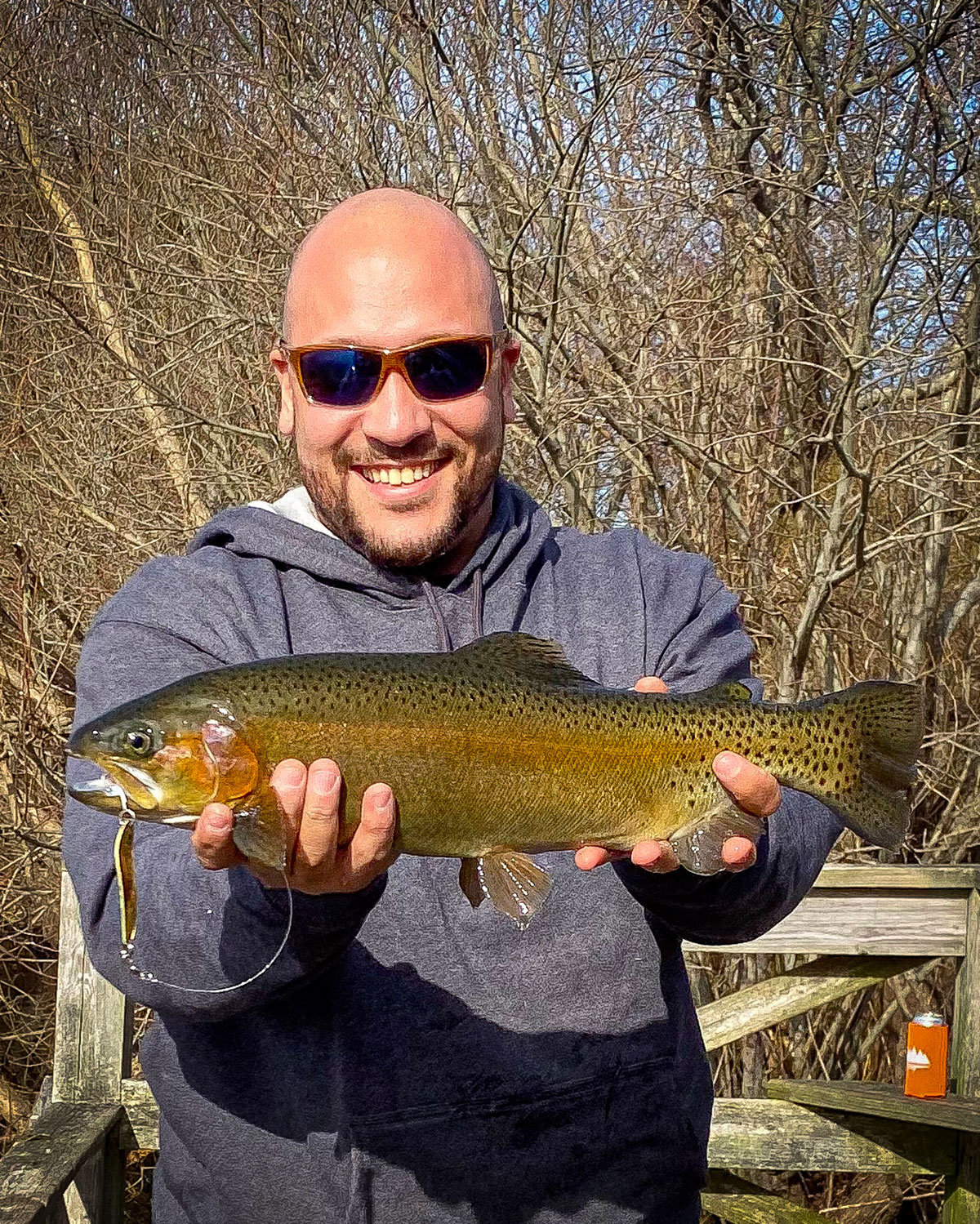
Trout fishing around your work schedule starts the day off right and kicks the season off on the right foot, too!
All the signs are here. Crocuses are sprouting and the spring peepers have begun their annual chorus. So too have all the local muscle cars and corvettes as they emerge from their winter slumber and rumble down my street. The “googan berries” (aka massive bobbers stuck in the tree branches) are in full bloom! We’ve managed to wrestle free from winter’s icy grasp.
While I never really stop fishing for trout, there is definitely an anticipation that builds as the days get warmer, the sunsets get later, and the fishing (usually) gets easier. Of course, if you fish in Rhode Island, you’ll have to contend with a brief pause from March 1 until the second Saturday in April (an event worthy of its own article for better or worse) but in the neighboring states of MA and CT the party starts early as the stocking trucks have already been hitting the road and anglers already hooking fish.
In the spring, freshly stocked fish might be plentiful, but if you’re anything like me, you might find that time to chase them… isn’t so plentiful. I suppose that’s what I get for having multiple expensive, time-consuming hobbies. That being the case, making some time to tighten a line around the hours I work to afford the things I enjoy makes the rat race bearable. Opportunities abound despite the limited time, if you plan ahead and finagle a way to incorporate them into your work schedule.
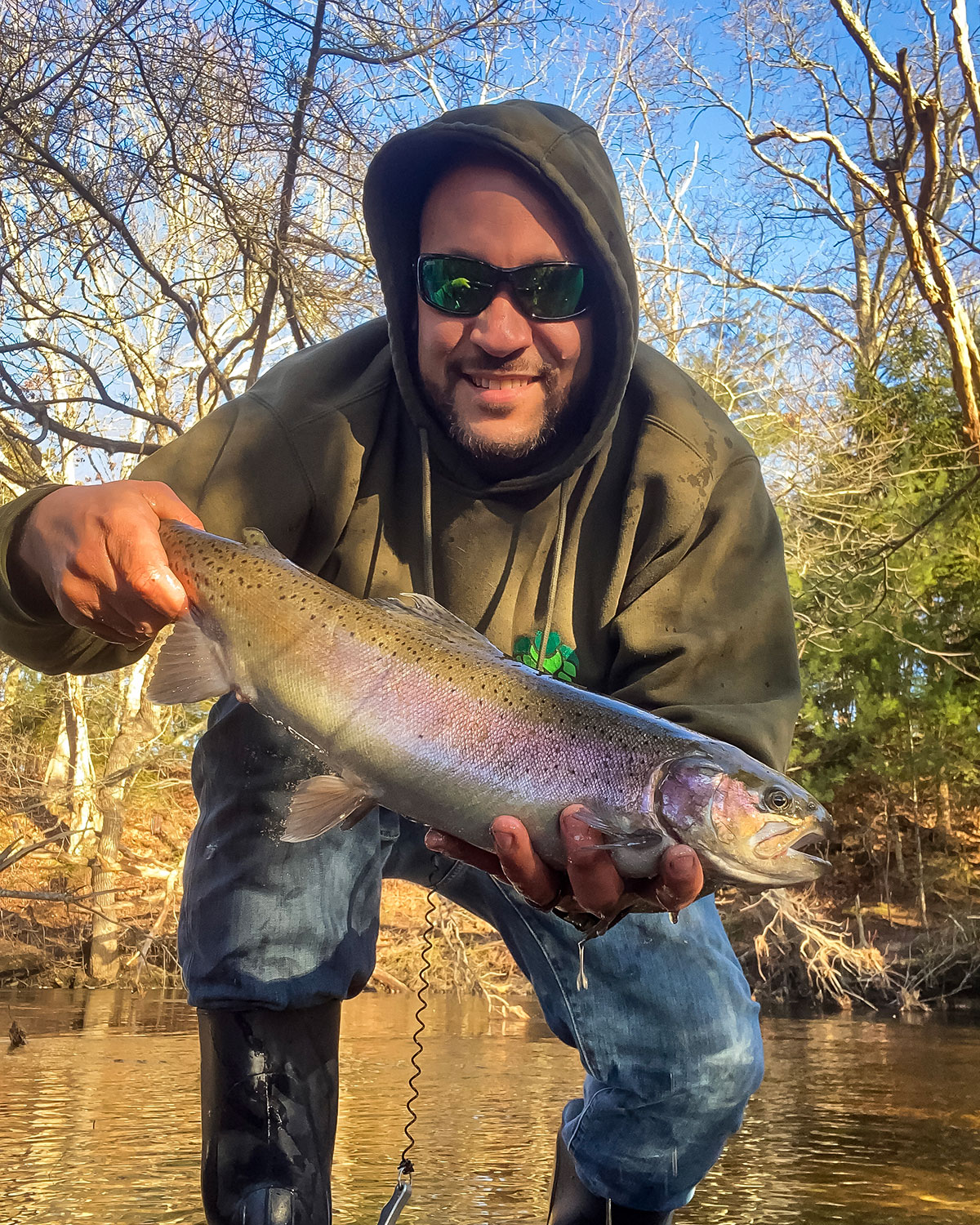
Keep It Tight
To make the most of these short-lived workweek windows I need to be ready to rock before I hit the road. I have what I jokingly call a “bug out bag” for those days where a quick strike before (or after) work is in the cards. Packing light is key, if I don’t have time for an extended trip there’s no sense in bogging myself down with multiple tackle boxes. A small waterproof Plano 3540-1 will fit all of my stocked trout staples. A couple brightly colored Rapalas (Husky Jerk HJ6, Countdown CD5, Xraps) a few spoons (Mooslook Wobblers, Thomas Buoyant Rough Riders, Krocodile Die #4’s) along with a few assorted streamers, tubes, spinners and jigs and I can cover most any situations I’ll encounter on my way.
Of course a cheap pair of pliers with cutters is needed, and a spool of 6-pound test fluorocarbon is normally sufficient but I sometimes bring a spool of 10-pound with me as well. Bass fishing is great this time of year too…they are a great plan B in some of the trout ponds and I want to make sure I’ve got the ability to crank one in if needed. All of this gear should fit in a soft-sided lunch cooler. If you can’t bring it into your job, it should at least be concealable and easy to pack into your vehicle.
I don’t go overboard on the rod and reel here either. I’ve got a basic do-it-all freshwater setup which consists of an old Shimano Stradic 2500 paired with a two-piece St. Croix Premier PS60MF2. The reel is also used for several other freshwater species so it’s spooled with 15-pound braid. Again, you want something that’s easy to transport and stow away. Versatility is key, and tactics depend on where the latest stockings have taken place. This setup is happy to lob a spoon across a pond and can still be somewhat accurate with light baits too. Of course, don’t forget the boots! You don’t want to roll up to the perfect spot only to find out that fishable water is just beyond your reach because sopping wet steel toes are not fun on a 10-hour day or muddy footprints are “frowned upon” in the office.
Make A Plan
| DON’T FORGET |
| Cooler – Keeping some fish for dinner? You’ll want to keep them cold. I find that burying a cooling rack (or anything that keeps the fish from sinking to the bottom as the ice melts) in the cooler helps keep the catch pristine condition as opposed to them sitting in meltwater for hours while you’re at work.
Towels – South Park was right, “don’t forget to bring a towel!” Keeping clean in the field makes pre-work cleanup way easier…M’kay Toothpaste – Don’t be “that person” reeking of fish in the office. Toothpaste does a great job of eliminating odors on your hands. Bonus points for it being non-harmful to the environment, so you can wash your hands in the same water you’d just fished. Insurance – Check with your provider on this one but if you plan on leaving gear in your vehicle while you’re at work, you’ll want to make sure it’s covered. Breakfast – With time at a premium, I like to make sure I’ve got something like a breakfast bar or premade egg sandwich that I can grab and eat on the road (or at my fishing spot). Nobody likes a hangry coworker! |
Having a plan is key when time is tight. I want to know where I’m going before I go to bed. All of the southern New England States are pretty good about telling you where and when they stock the ponds and rivers. Most states have a webpage that’s updated daily, and will give you the locations where fish have been stocked. Social media is here to stay, whether we like it or not, so make sure you set an alert for new posts. The RI DEM often posts the day of when they drop off fresh fish. It’s always nice to be the first person on them, if you can find a way to sneak out early. With this information it’s easy to map out where you can deviate from your commute and bag a few fish on the way to or from.
When should you go? The best answer is “whenever you can” of course. Sometimes an iced coffee on a riverbank before work just “hits different” as the kids say. Same thing goes for that first frosty cold beverage after a tough day in between work and home.
There are of course, days where you might want to devote more time to fishing and less to work (or sleep) if that’s an option. I like to focus on the barometer. A sharp drop in pressure on a warm day, ideally with clouds or light rain is what I look for. The best scenario is when this coincides with dawn or dusk, these are great times to fish anyway and are also times when most of us don’t have to work.
Predicting the weather is a guessing game, but if I think I’ve got a shot at a dawn bite and I can be in for 9, I’ll set my alarm early. I’m much more pleasant at work if I’ve checked off “catch a few fish” before I clock in, even if it means losing a few Z’s. If I’m on the nightshift, waking up early isn’t an issue if I have time for a power nap in between. Sometimes I‘ll even call in a favor “hey can you come in early so I can jet at 3:15 pm and fish on the way home”. However, I try to save these favors for saltwater endeavors instead of stocked trout.
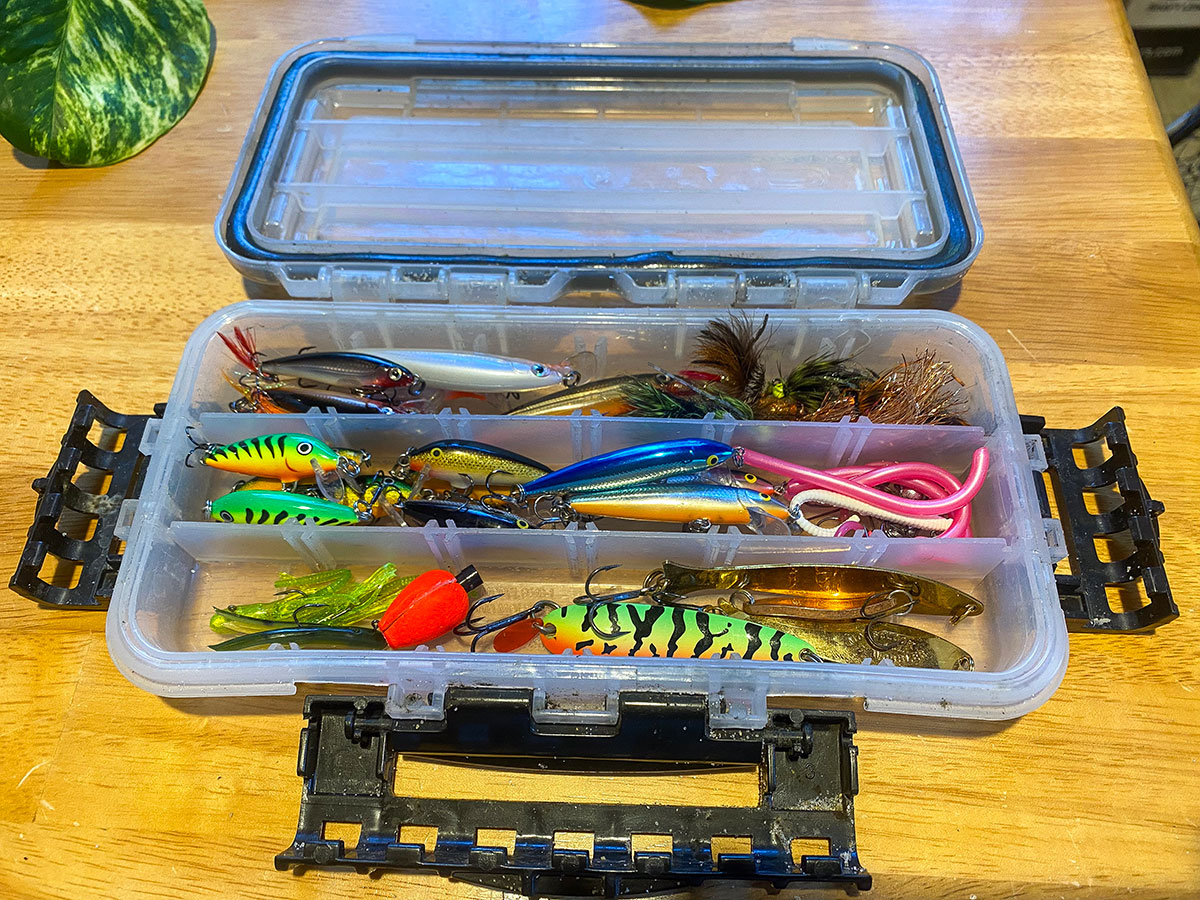
Tactical Trout
Getting it done depends on numerous factors but here are a few pointers. If you’re fishing rivers, aim for bridges. A bridge crossing a river will often have a deep pool on the downstream side, providing a refuge for trout. Pilings can provide a current break where fish can rest or ambush prey. On sunny days, the shade provided sometimes means the difference between a few fruitless casts and a fish or two on the bank.
I love fishing jerkbaits in rivers; heavy currents dictate a heavier, or should I say “faster sinking” lure. Slow flows mean casting down-current and working upstream. A faster current might mean strategically working your lure in a perpendicular fashion to the direction of the river. Tubes and streamers are also great here; the former for faster water, the latter for slower flows and back eddies. I reserve most of the spoon fishing for ponds but the Mooslook is killer in a gentle river.
An absolutely deadly tactic that I’ve been using recently is to fish a small jig under a strike indicator, like the ones made by Trout Magnet. I use small jigheads with a rubber worm “tail” and set the float so the jig bounces along the bottom. Once you’ve got the rig drifting into the strike zone a couple random twitches of the rod to augment the natural action of the bait are all that’s needed. I’ve managed to catch (and release) limits of fish in areas where I thought there were only a few
Lakes & Ponds
Should the latest report (or your route) dictate a pond or lake, covering as much water with longer fan casts is an effective tactic. The Krocodile and Rough Rider shine here. Sometimes the fish respond to the bigger flashier spoon, other times the smaller option will draw strike from more finicky fish. From what I’ve experienced, the Krocodile seems to have the edge in the fall, and the Rough Rider is king of the spring. I’ll often give a set number of casts to one lure then switch to the other if I don’t get a hit.
Keep in mind that if the fish have recently been dumped into the pond, they tend to stay close to that location. You’d think, after a life of swimming in circles, they’d head for the hills upon hitting the water. But that is not the case. I’ve been fortunate enough to be on a boat (or jobsite) when the stocking truck backs down the ramp more than once and I’ve found the majority of them don’t go very far. So start where the fish entered the water. Even after trout have been in the pond for a couple days they seem to maintain a circular cruising pattern before they figure out that they’re no longer in a tank. Eventually they’ll spread out in to “fishy” areas. And you’ll have to adjust accordingly.
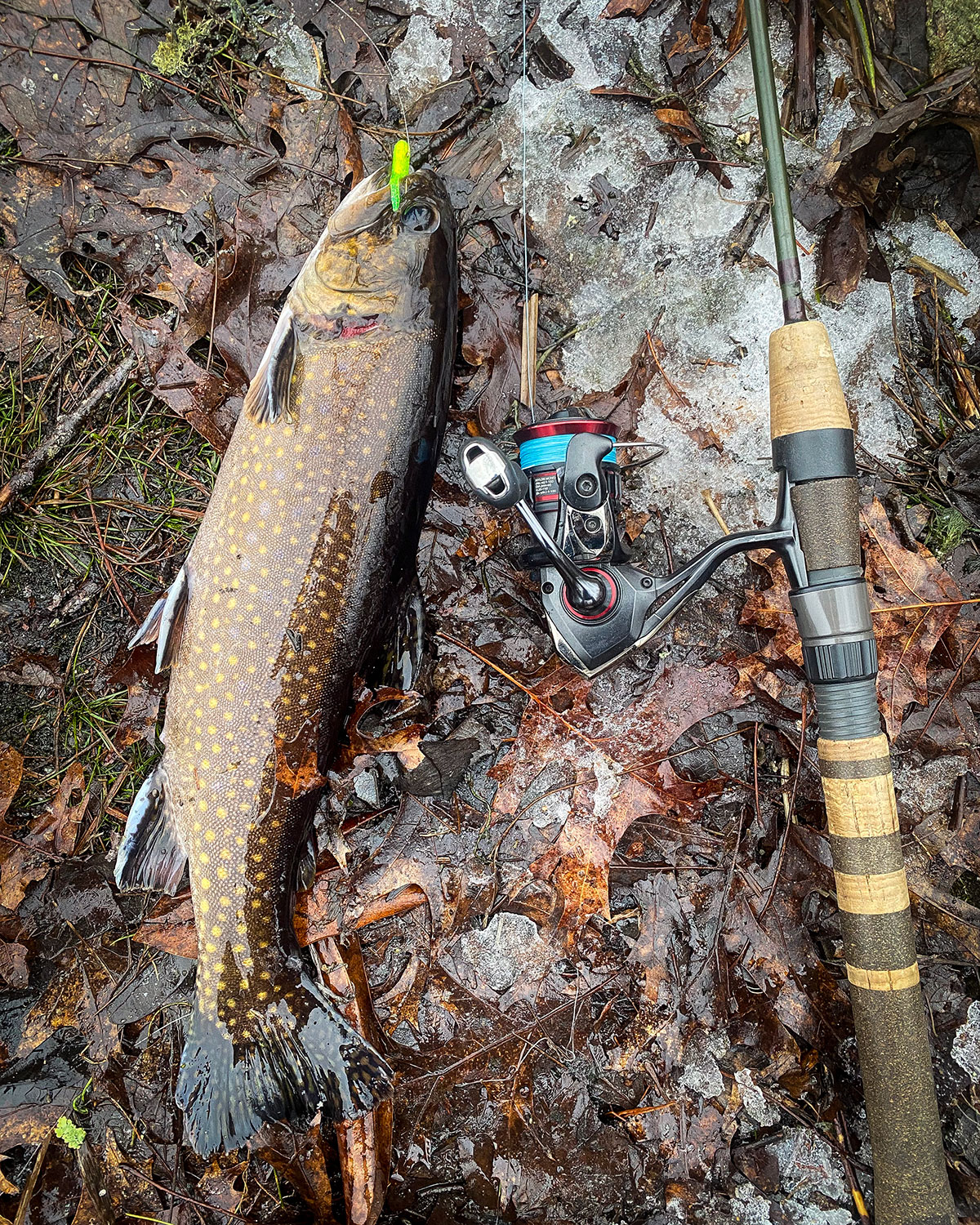
A Better Work Day
Some of my favorite memories of combing working and fishing come from my days at the Old Gristmill Tavern in Seekonk Massachusetts. I knew the state would be stocking and made sure I’d packed my gear in the truck. We were doing a complete rebuild of the restaurant (which is on a pond) and were in the demo phase. Midway through lunch the state truck showed up and dropped 125 trout into the pond. I don’t remember what I had for lunch that day, but I can tell you I didn’t finish it and grabbed my gear from the truck. I managed to nail a few fish before I had to put the rod down and pick up a sledgehammer. After the day was done, I caught fish until the sun went down. After that I followed the stocking reports and showed up to work early to fish the pond or nearby streams for as long as I was swinging a hammer or slinging drinks there (after we rebuilt the place).
We’ll soon be on to bigger and better things. This is a short season, sort of. It won’t be long before I’m banking the sleep hours and flex shifts for chasing bigger quarry in the brine. But for now I’ll stick to a little pre/post work decompression to keep management off my back. For some reason my “constructive criticism” is much more “appropriate” if I manage to play my cards right and catch a few fish on work days. That being said, this season doesn’t really end. It might be overshadowed by bigger game but there’s almost always a way to get out for some fish-therapy in a pinch if needed. More on that in the next installment!

